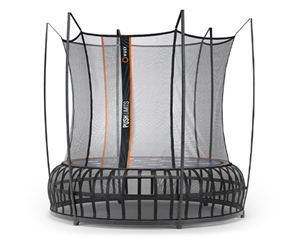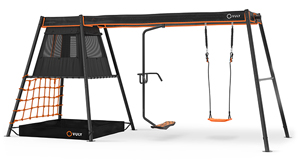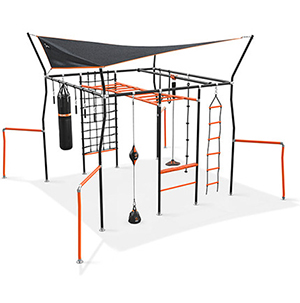
Recommended Amount of Physical Activity for Children & Adults?
Dec 03, 2023
3 mins
There has been a lot of debate about the importance of physical activity internationally - specifically, how much physical activity is recommended for good physical and mental health.
Only half a century ago, this wasn't much of a concern. Physical activity was much more prevalent in everyday life. From transport to leisure time activities, kids and adults alike participated in significantly more physical activity, whether knowingly or accidentally.
Over the years this has decreased year on year - with technology taking prevalence, sedentary behavior has infiltrated every aspect of our lives - from entertainment to work. As a way to spread awareness and try to reverse this trend, governments around the world have issued physical activity guidelines as a way to reduce the negative economic, health, and social effects of reduced physical activity.

Recommended Amount of Physical Activity for Children
| Age Group | Physical Activity | Sedentary Recreational Screen Time |
|---|---|---|
| Under 12 months | Interactive floor-based play, 30 minutes of tummy time daily | None |
| 1 to 2 years | At least 3 hours of energetic play per day | None |
| 3 to 5 years | At least 3 hours per day, 1 hour of energetic play | No more than 1 hour per day |
| 5 to 17 years | 1 hour of moderate to vigorous activity daily, several hours of light activities | 5-13 years: No more than 1 hour per day 14-17 years: No more than 2 hours per day |
During childhood, we undergo rapid development, both physically and mentally. Physical activity greatly benefits children and is important for natural and healthy development.
It's therefore unsurprising that the physical activity recommendations for children are higher than for adults. Although there are some differences between the recommendations given by various government agencies around the world, they all set very high daily recommendations for physical activity for children and very low recommendations for sedentary behaviour.
Children under 12 months are expected to have almost unlimited interactive play, whereas children between 1 and 5 should have a minimum of 3 hours of play, whereas kids aged between 5 and 17 have several hours of activity, including 1 hour of moderate to vigorous activity.
Children under 2 shouldn't have any sedentary recreational activity, children between 2 and 13 shouldn't have more than 1 hour, and children 14-17 shouldn't have more than 2 hours of sedentary recreational activity per day.
The type of physical activity recommended for younger children is usually more unstructured play like playing on monkey bars and trampolines, compared to teens mostly participating in sports and structured physical exercise.

Recommended Amount of Physical Activity for Adults
| Age Group | Physical Activity | Strength | Sedentary Time |
|---|---|---|---|
| 18 to 64 years | Most days: 2.5 to 5 hours moderate or 1.25 to 2.5 hours vigorous activity, or combination | At least 2 days a week | Minimise and break up long periods of sitting |
| Pregnancy | Most days: 2.5 to 5 hours moderate or 1.25 to 2.5 hours vigorous activity; Pelvic floor exercises | At least 2 days a week | Minimise and break up long periods of sitting |
| 65 years and over | At least 30 minutes moderate activity most days | Fitness, strength, balance, flexibility activities | Not specified |
The physical activity recommendations for adults (18-64 years of age), including during pregnancy, are 2.5 to 5 hours of moderate physical activity or 1.25 to 2.5 hours of vigorous physical activity per week. For people over the age of 65 30 minutes of moderate physical activity most days is recommended.
These are significantly less than for children and teens. For adults, the story is somewhat different. As we get older our aim with physical activity is to maintain our bodies. Regular physical activity is crucial for adults as it offers numerous health benefits, including improving cardiovascular health, enhancing muscle and bone strength, and reducing the risk of chronic diseases such as diabetes, heart disease, and certain cancers.
In fact, studies exist that show that muscle mass decreases due to something called sarcopenia, a type of involuntary muscle atrophy. Muscle mass decreases approximately 3–8% per decade after the age of 30 and this rate of decline is even higher after the age of 60 according to the NIH. Exercise, and specifically strength training, is known to reduce aging-related sarcopenia.
Regular physical activity plays a significant role in improving mental health for adults. Engaging in exercise can lead to the release of endorphins, often referred to as 'feel-good' hormones, which can enhance mood and create a sense of well-being.
Physical activity also helps in managing stress, anxiety, and depression. It can improve sleep quality, which is closely linked to mental health. Furthermore, exercise offers opportunities for social interaction and a sense of achievement, both of which can boost self-esteem and confidence. By creating a positive cycle of well-being, regular physical activity becomes a powerful tool in maintaining and improving mental health.
Staying active promotes better sleep, boosts energy levels, and enhances overall quality of life. Incorporating physical activity into daily routines, whether through structured exercise or more casual physical pursuits, is essential for long-term health and vitality.
As we get older we also start to become less flexible and our range of motion gradually becomes less and less. Stretching becomes increasingly important for older adults to maintain fitness and independence.
Balance and coordination are extremely important for older adults as well. The elderly are prone to falling, and their bones become more prone to breaking as they age - a recipe for disaster. Doing balance exercises and strengthening stabilising muscles can considerably reduce falls and subsequent injuries.





















































